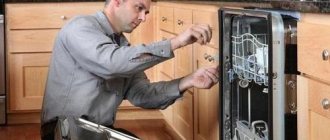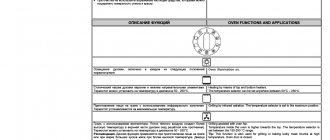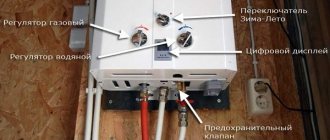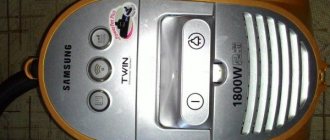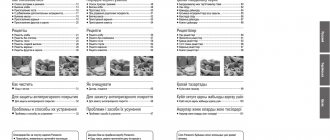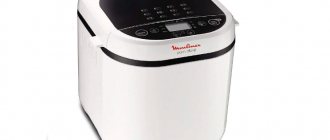Guy getting to know the car
Page 6
- Image
- Text
gi
Getting to know the car
Drawings depicting the panel
controls and internal equipment
dishwasher, you will find the instructions on the cover at the beginning. In the text you will find footnotes relating to individual items.
Control Panel
I ( “ON/OFF” switch I 0 Program selection buttons ** I 8 “Check feed” indicator
water"
I @ Indicator of the presence of a special
salt
I N Rinse aid indicator I P Start timer * IX Additional functions ** I ' CTAPT button I ^ Digital indicator 11″ Machine door handle
* Depending on the model ** Quantity depending on the model
Internal equipment
dishwasher
I 2″ Storage box I 2* Shelf for knives * I 22 Stand for detergent tablets
facilities
I 2″ Better spray
rocker
I 2B Bottom spray
rocker
I 2″ Container for special salt I 2″ Filters I 2L Cutlery basket I 2″ Bottom box I 2″ Container for rinse aid 13″ Detergent chamber 13* Latch on detergent chamber
facilities
132 Type plate
*Depending on model
6
Typical breakdowns and error codes of a Siemens dishwasher
The design and principle of operation of the Siemens PMM is practically no different from other models. But some problems are especially typical for this brand. If an error code appears on the display, look at the instructions. The manufacturer indicates the meaning of the icons. And if you want to find out the details of solving the problem, the article “Fault codes for Siemens dishwashers” will help.
Here are the most common ones:
- E1 - water does not enter the tank.
- E7 - drying does not work.
- E9/E10 - the machine operates without heating.
- E15 - the Aquastop leakage protection has activated.
- E21/E23/E24 - water does not leave the tank, problems with the drain pump.
- E27 - incorrect network voltage.
How can you determine what is broken in the dishwasher if the code does not light up on the display? To do this, pay attention to the external manifestations of the breakdown. What users most often contact the service center with:
- The machine draws water slowly, the program freezes in the middle of the cycle . The reason may be a clogged filler path or a malfunction of the solenoid valve.
- PMM does not wash dishes well . The main problem is blockage. It is also possible that the circulation pump may break down or due to operating errors.
- The drain doesn't work . The problem is a clogged filter and a blocked pump impeller. Pump failure requires replacement.
- The program is not selected, the equipment is turned off . Problem with the electronic module.
Some problems can be solved at home. Follow our instructions below.
Similar competitor models
The main guideline for choosing equipment is not the cost, but the dimensions and installation method. After all, models are selected for placement in a specific kitchen and for a not at all abstract family. Let's look at options for dishwashing equipment that can compete with the unit discussed in the article, taking into account the specified criteria.
Competitor #1 – Electrolux ESL 94320 LA
A narrow unit that is completely built into kitchen furniture is somewhat more energy efficient than the “hero” of the article. When washing 9 sets, it consumes only 0.7 kW per hour. It uses more water - 10 liters, and is a little more noisy, measured at 49 dB.
Electrolux ESL 94320 LA is controlled by push-button electronics; there is a panel with LED indicators to monitor operating data. Using a timer, you can postpone the start of the wash by 3... 6 hours. Unlike the machine shown in the article, this model does not have a half-load function. But there is a device that determines the degree of water purity, automatic shutdown and extra drying.
Disadvantage: there is no blocking system to prevent children from interfering in the process of programming and operating the device.
Competitor #2 – Bosch SPV25CX01R
An interesting option for those looking for a compact, fully built-in dishwasher. The model from the German brand is equipped with an inverter motor, which ensures quiet operation (46 dB) and economical electricity consumption.
The price for Bosch SPV25CX01R starts from 20 thousand rubles. For this price, the buyer receives a multifunctional kitchen assistant. The unit has 5 washing programs, including the VarioSpeed express cycle and gentle processing of glassware. There is a child lock, rinse aid/salt indicators, and a sound signal.
Users are satisfied with the ease of loading, quality of washing, spaciousness, ease of installation and ease of operation. Identified shortcomings: does not always remove burnt-on food residues, lack of a timer.
Competitor #3 – Midea MID45S100
The model attracts with its price, the lowest of the units given as an example, and economical consumption of resources. To wash 9 dish sets, she will need 9 liters of water and only 0.69 kW of energy per hour of operation. It will sound at 49 dB.
Midea MID45S100 has 5 working programs. The unit processes dishes with a half-loaded tank and, if necessary, performs extra drying. It is controlled by push-button electronics and is equipped with a panel with LED indicators to monitor operating data. Equipped with a timer that allows you to postpone the launch for a period of 3...9 hours.
Almost traditionally, built-in narrow type dishwashers do not have protection from the younger generation.
What is the correct name for the Siemens PMM algorithm?
In various user manuals, on thematic websites, and simply on the Internet, in relation to dishwashers and their algorithms, one comes across such terms as “program”, “cycle”, “mode”. Is there any difference between them or do they all mean the same thing? In fact, there really is no difference. All these concepts characterize in the PMM a certain algorithm laid down by the manufacturer, which includes a number of parameters and is designed not only to wash dishes, but also to implement a number of other capabilities:
- keep dishes intact;
- delicate modes are especially gentle when handling fragile dishes;
- soak and help remove dried residues from the dishes;
- rational use of resources;
- dry dishes.
You can’t list everything in one list. But the main goal of any regime is still the same - to wash the dishes well. And in order for the dishwasher to surely cope with this, it cannot be done without the initiative of the user, who should carefully read the description of the programs and make the right choice.
Icons on a bosch dishwasher symbol designation
The dishwasher is equipped with a control panel. Regardless of the type (electronic or mechanical), any panel is equipped with indicators and keys. These elements make it easier to select programs and allow you to understand the settings and modes. Bosch dishwasher indicators are no exception. It will be useful for you to know what the blinking of a particular light bulb means.
Description of controls
In everyday use, a Bosch dishwasher is unlikely to cause much difficulty in use. Many lights and modes remain unused. But to use a Bosch dishwasher comfortably, you need to know what each of the signal indicators means. Let us first consider those that are present on almost all models and indicate various stages of work.
- “End” indicator – indicates the end of the dishwashing cycle.
- “Brush” indicator – lights up when the dishwasher starts.
- “Tap” indicator – signals the period of operation when the cavity of the machine is filled with hot water.
- The “Salt” indicator (two arrows in the shape of the English letter S) - indicates the presence of a salt absorbent, which helps clean the heating element from scale that has formed on it.
- The “Rinse aid” indicator (snowflake, sun, star) indicates the presence of dishwashing liquid in a special compartment.
The keys responsible for setting and regulating the upcoming wash are allocated to a separate category. The functionality of each Bosch model is very different, so only those buttons that are most common will be described.
- “Pan” - this symbol indicates an intensive mode of washing dishes at a temperature of more than 70 degrees Celsius and lasting about an hour. Used for the heaviest stains.
- “Cup and saucers” (or Auto mode) is the standard operating mode. Similar to when we wash dishes by hand. Water temperature - 50 degrees. Duration – up to two hours.
- “Cup and plates” (ECO, economy) – mode of reduced water consumption. It differs from the standard one in the presence of a rinsing stage.
- “Glass (cup) with two arrows” – accelerated washing. It passes in half an hour at a temperature of about 40 degrees Celsius.
- “Glass” – delicate mode. Used for fragile dishes.
- “Baby food bottle” – treatment of dishes with hot water, which destroys germs. Used to disinfect baby supplies (dishes, pacifiers, etc.).
Suitable detergents for dishwashers
For Bosch dishwashers you can use all types of detergents offered by manufacturers of household chemicals:
- liquid;
- powder;
- compressed tablets.
The only requirement for such products is that they must be specialized (that is, intended for use in dishwashers).
It is recommended to use conditioner during the drying process. The purpose of this additive is to speed up the drying of dishes and eliminate traces of drops from their surface. The amount required for a good result can be determined in practice. If the volume of conditioner is insufficient, smudges will remain on the surface of plates and glasses. If there is an excess of it, the dishes become covered with colored stains.
Another important component for the correct operation of the device is water softening salt. Its absence can lead to the appearance of scale on the main components of the device.
We invite you to familiarize yourself with Fabric for an outdoor gazebo
Some manufacturers offer 3 in 1 products, where all of the above components are combined (Bosch Logixx Automatic dishwasher). Their main disadvantage is the inability to regulate the amount of salt.
Dishwasher users must purchase a starter kit, which is usually offered with their main purchase. You can separately purchase rinse aid, detergent tablets or special powder, as well as salt to soften tap water, which we have already discussed.
The starter kit includes all the detergents, without which it is simply impossible to operate any dishwasher - this is a mandatory minimum
The advantage of starter kits for beginners is that they already include everything you might need. In addition, they include products from the same manufacturer, which allows us to hope that their components are not only perfectly compatible, but also successfully complement each other.
Often, purchasing a set will cost less than purchasing its components, sold separately from each other.
In addition to the three absolutely necessary components, fragrances and products can be used for effective washing to help clean the car itself from grease and plaque. As a rule, they are purchased as the need for them arises.
For high-quality dishwashing, soft water with a low content of calcium salts should be used. If hard water is not softened, scale marks will form on the walls of the chamber over time. Salt allows you to bring water to a state in which the results of the equipment’s operation please its owner.
Regenerating salt for loading into the dishwasher should not be confused with ordinary table salt, which everyone has in their kitchen: this is a special substance for softening tap water
Bosch machines can use any detergent that is on sale today.
It can be:
Source: https://zamena-iphone.ru/instrument/panel-upravleniya-posudomoechnoj-mashiny-bosch.html
Icons on the dishwasher: designation, symbols, photos
The functionality of modern cookware, along with technical progress, is developing at a rapid pace; if you fall behind a little, you are already “out of trend.” The variety and latest materials from which manufacturers make tableware consistently shock our consciousness. It is impossible to always be aware of what new products appear on the market, what material this or that dish is made of and how to use it correctly so as not to harm your health.
Our grandmothers' kitchen arsenal was much simpler - an aluminum pan, a cast-iron frying pan and a ceramic pot, and the cooking conditions were on a gas or electric stove. Modern housewives can't get off that easy! There are so many modern appliances in the kitchen - glass-ceramic, induction cookers, microwave ovens, dishwashers - and you need to be friends with each one, know what kind of cookware to use, how to wash it and under what conditions to store it.
You can’t do without encyclopedic knowledge!
Manufacturers are trying to simplify this task for us; on every dish today you can find markings that tell you what action to perform with this dish is allowed or what conditions are allowed and, conversely, what is prohibited.
The presence of certain symbols depends on the characteristics and properties of the material. And we must know these hieroglyphs, which are incomprehensible at first glance, in order to use the dishes correctly. After all, ignorance can harm your health and damage equipment and utensils. But we want to be healthy and want our favorite dishes to last as long as possible.
Every kitchen today has non-stick cookware, and every housewife wants the product not to fry on the pan, and the coating to last longer. In induction, ceramic and silicone cookware you also need to be able to cook and you need to understand under what conditions. A real “alphabet” of pictograms in a visual language that we understand will help us with this. Small icons on the dishes will prompt and inform you about the required operating conditions for each dish individually.
Professionals advise choosing dishes for preparing and storing food correctly and then everyone will be healthy. Please note that in the decoding table the manufacturer often provides information about the additional properties of the product. Get acquainted, remember, use knowledge in practice and you will keep up with the times healthy.
Basic icons on a dishwasher: meaning and operating features
What housewife doesn’t dream of getting rid of the daily task of washing dishes with her own hands? Today this desire is easy to satisfy, because there are so many different household appliances on store shelves that can wash plates and cups for you. Therefore, let us further in this article discuss in detail the main icons on the dishwasher: their meaning and operating features.
Relevance of the acquisition
Humanity is constantly trying to make its life as comfortable as possible. Many research institutes carry out lengthy development and testing of new household appliances. Not long ago, such a useful invention as a dishwasher appeared on the domestic market. Look at the following photo depicting a similar Bosch technique.
This is a unit whose purpose is to clean various types of dishes from dirt. Moreover, such equipment is used both in everyday life and in public catering places. There are many symbols on its panel. The housewife just needs to place the dirty dishes inside the dishwasher and, by clicking on the necessary icons on the bosch dishwasher, turn on the required operating mode of the device. The machine will wash the dishes itself. At the same time, the presence of hot water supply in the house is not at all necessary. After the time specified by the washing program, the unit will finish its work.
Thus, Bosch technology allows a person to free himself from part of the daily housework. That's why she's so popular.
Advantages of units
Note that this device has a number of very important advantages:
- Numerous studies have shown that the presence of a Bosch dishwasher in the house leads to a reduction in water supply costs by several times;
- Ariston units, as well as other brands, are characterized by low energy intensity;
- affordable price;
- a wide variety of models with different capacity, power and functions. The possibilities of such household appliances are really very wide. Modern options have a number of important features and clear icons;
- variety of operating modes;
- Bosch equipment has a simple control method. The housewife just needs to learn the main icons on the dishwasher panel and their designation.
What should you pay attention to when choosing?
There are a large number of dishwashers on the market. Before purchasing, be sure to read the instructions for use so that you know how to use the dishwasher and have an understanding of its technical characteristics.
Important! If you plan to install and connect the dishwasher yourself, be sure to read our tips. We have prepared separate reviews:
To choose the most suitable option, you need to consider the following factors:
- Type of machine: free-standing or built-in. The built-in option will save quite a lot of space in the kitchen.
- Device dimensions. On average, a dishwasher can accommodate 10-13 sets of dishes. This is the optimal amount of dishes after receiving guests or for a large family. Compact size machines can accommodate 8 sets. This is a good option for a small kitchen. However, such devices do not cope with cleaning pots and pans.
- Energy consumption class (indicated by letters of the Latin alphabet). The higher the class, the more economical the device is. The most economical devices are class A (energy consumption is 800-1050 W).
- Set of functions. In addition to the standard functionality (pre-wash, rinse, dry), more expensive models also have other functions (Eco, intensive wash, quick wash, “washing fragile dishes” function).
Important! The following additional options are desirable:
- Protection: from children, from leakage.
- Half load mode.
- Delayed start.
- Self-cleaning from food waste.
- Possibility to change the height of the basket.
Dishwasher indicators and symbols - meaning
As soon as the connection work is completed, the user understands how to start the equipment. To do this, you need to understand what the icons and indicators on the dishwasher panel mean. If you don’t have the instructions at hand or you don’t understand the manufacturer’s instructions, our article will help.
Identification of signs on the dishwasher
The location of the panel depends on the type of dishwasher. If this is a built-in model, the keys and indicators are located at the end of the door. Since the front part of built-in PMMs is hinged, there is no need to place the control system on the front part of the door.
Freestanding machines are a full-fledged element of the interior, so the control panel is located on the front part. Buttons and indicators may be labeled, but often these are foreign names that cannot be understood without instructions. It is more convenient when the keys are designated by symbols: pan, snowflake, asterisk. Then the user can intuitively understand the meaning of the buttons.
The variety of symbols depends on the brand of the car (Ikea, Ariston, Siemens). And also on the number of functions of the model.
Let's look at the designations of the most popular brands of dishwashers.
Bosch (Bosch)
Bosch dishwashers are the most popular on the Russian market. Manufacturers have created a wide range of models, a wide variety of modes and are introducing new technologies. Let's look at the decoding of the most common symbols (follow the numbering in the picture).
- Pan with stand (1). The symbol speaks for itself - intensive mode (70 degrees), which allows you to wash heavy dirt from pots, baking sheets, and frying pans. Duration - 115 minutes, water consumption - 21 liters.
- Auto (cup and saucers) (2). “Automatic” mode (one might say “Standard”) takes place at a temperature of 45-65 degrees. Suitable for a variety of dishes, except for items made of delicate materials. Operating time - 140 minutes, consumes 19 liters.
- ECO (Economical Cleaning) or glass and cup on a plate (3). Initially, a “Pre-rinse” is carried out, and then a program at 50°C. Lasts 140 minutes, spends 14 liters.
- A glass with a cup on a stand and two arrows to the right (4) - a quick cycle without an initial rinse at 45 degrees. Characteristics: 30 minutes, 10 l.
- “Shower” of water drops (5) – “Pre-rinse”. The program allows you to clean dishes from food residues and prepare appliances for a thorough wash. Time: 19 minutes, water: 4 l.
- One glass. Indicates “Delicate wash”, works at a temperature of 40 degrees. In this case, you can wash fragile items. Takes 75 minutes, spends 15 liters.
- Plus and minus with the letter h (6) - allow you to adjust the cycle time.
- Clock with arrows to the right (7) - reducing the duration of the mode by half (VarioSpeed).
- ½ (8) - half load mode. If you haven't collected dirty dishes for a full cycle, load only half with a 30% resource saving.
- Pan with rocker arms (9) - “Intensive Zone”. Water flows into the lower part under stronger pressure than into the upper part.
- Baby bottle (10) - the hygienic mode allows you to process dishes at high temperatures. Perfectly disinfects children's dishes.
Start and Reset keys on the panel will help you start a wash cycle or perform a reboot.
In addition, the dishwasher control is equipped with operation indicators. They inform the user about a particular program. Let's figure out how to understand the meaning of the light bulbs on the Bosch panel.
- Brush (1) – washing indicator.
- End (2) — end of the program.
- The faucet icon (3) is a water supply light.
- Wave-shaped arrows (4) indicate the presence or absence of salt in the ion exchanger.
- Sun (snowflake) (5) - presence of rinse aid in the compartment.
In dishwashers with a display, the wash modes are also equipped with lights. If they light up, the program is running.
- Icon + (1) - the ability to select a temperature in the region of +65-75°C.
- Auto (2) — automatic washing.
- “–” symbol indicates the temperature range from 35 to 45 degrees.
- Eco (4) - economical program.
- Glass and cup on a stand (5) - quick cleaning.
- Water jets (6) - pre-rinse.
There is also a time indicator on the floor and on the display. In the first case, numbers are displayed on the floor that indicate the time until the end of the program. The latest models have a "Beam on the Floor" function. Instead of an audible signal indicating the end of the cycle, the machine flashes a beam.
Why is the indicator blinking?
It happens that the lights on the dishwasher begin to blink, notifying the user of a violation in the program. If the “faucet” indicator and the “End” icon are flashing, there are problems with the water supply. What is the reason:
- The shut-off valve is closed.
- “Aquastop” worked and blocked the access of water.
- Problems with board components.
Read more about this in the publication The “faucet” indicator is on in the Bosch dishwasher.
Hotpoint Ariston (Ariston)
Dishwashers made by Ariston are easier to operate. The symbols on their panel are clear and easy to remember by the user.
- The indicator marked with the letter S (1) indicates the presence of salt. The one marked with a cross indicates the amount of rinse aid.
- Pot with three lines (2) - intensive washing under strong water pressure. Duration - 2 hours 25 minutes (± 15 minutes).
- Pot with two stands (pot with circle) (3) - normal washing mode. Lasts 1 hour 50 minutes (± 10 minutes).
- Eco (4) - “Economy” mode. Ecological washing at 50 degrees. Time: 2 hours 35 minutes (± 15 minutes).
- The letter " R" in a circle (5) - express washing and drying of dishes. For lightly soiled dishes. In just 25 minutes, it will clean 10 items immediately after eating.
- Three wavy lines (6) – “Soak” mode. If you do not have time to run a full cycle, or there are dried stains on the dishes, press key 6.
- Glasses (7) - “Delicate wash”. Lasts 1 hour 30 minutes (± 10 minutes), works at low temperature.
- Number 8 is the Start key.
- Button "P" - mode selection.
Comparison of prices and features
We compared dishwashers that cost approximately the same as the Siemens SR64E002RU. For the analysis, we used a newer model from Siemens and a device from the popular Bosch brand.
Compared to the Bosch SPV 40E10 machine, the Siemens SR 64E002RU uses water more economically - 2 liters less. It is also more economical in terms of power consumption, since it can be connected to hot water. It’s also worth noting that Siemens is much quieter in operation - 48 dB, while the competitor’s is 52 dB.
But the Bosch SPV 40E10 device is more convenient to use, as it has an electronic display, and safer - it provides child protection. The price of the Bosch model is slightly less than the other compared models.
Model 64M030 SR series, compared to SR 64E002RU, has more functions. Among them are child protection, an electronic display and a special beam that signals that the device is on and goes out after the program is stopped.
The noise, water consumption and number of work programs are identical. The cost of the SR 64M030 model is slightly higher. Whether to overpay for useful “tricks” is a purely individual decision.
